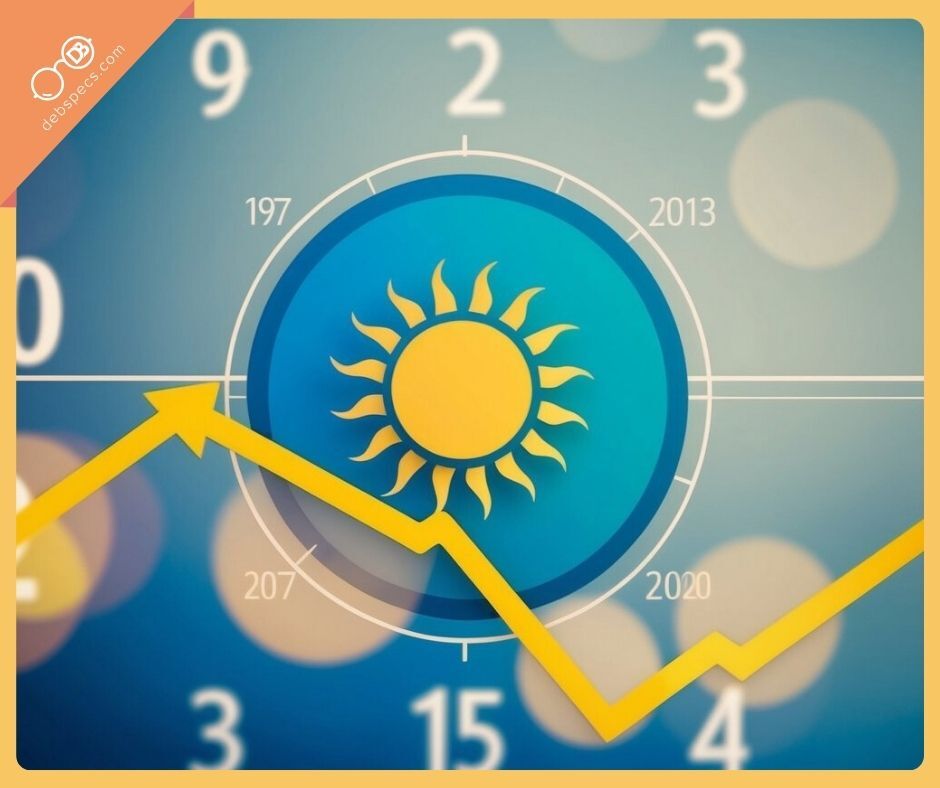
Sun Angle and Seasonal Reading: How to Choose the Perfect Reading Glasses Year-Round
Posted by Team Debby on 2nd Oct 2024
As the seasons shift, so does the angle of the sun—and with it, how we see and experience light every day. At DebSpecs, we know these changes don’t just affect the length of your shadow. They also influence your comfort when reading outdoors, driving at sunrise or sunset, and protecting your eyes year-round.
Let’s break down how the sun’s angle changes throughout the year, why it matters, and how the right pair of readers can keep your vision stylish and protected.

Why the Sun’s Angle Matters
The sun’s position in the sky isn’t static. It changes daily, influenced by Earth’s 23.5° axial tilt and its orbit around the sun. This tilt explains:
- Long summer days with stronger sunlight.
- Short winter days with softer, lower-angle light.
- Balanced spring and fall equinoxes with equal day and night.
These shifts impact everything from agriculture and climate to—yes—our daily routines. For those of us who love reading in natural light, it’s especially noticeable.

Keeping Vision Comfortable Through Changing Light
As the article explains, shifting sun angles and seasonal lighting can influence how easily your eyes maintain focus during close work. Readers designed for clarity, balance, and reduced glare can help support comfortable vision as these conditions change throughout the year. The options below show how thoughtful lens choices can adapt to the rhythms of your reading environment.
Solar Basics Made Simple
Earth’s Axial Tilt
- Causes the seasons as Earth completes its 365-day orbit.
- Summer = direct sunlight, warmer temps.
- Winter = angled sunlight, cooler temps.
Solar Declination
- The angle between the sun’s rays and Earth’s equator.
- Peaks at +23.5° in June (summer solstice, longest day in the north).
- Drops to -23.5° in December (winter solstice, shortest day in the north).
- Equinoxes = 0°, giving nearly equal day and night.
Think of it as the sun’s “dance pattern” through the year—predictable, but with dramatic effects.

How Sun Angle Changes Across the Globe
- Near the Equator: Sun angles stay fairly consistent. Days don’t vary much, and light remains strong year-round.
- Closer to the Poles: Light swings dramatically. Summers can bring near-constant daylight; winters, long nights and weak sun.
Your latitude determines how much sunlight you enjoy—and how much you squint.

Everyday Impacts of Sun Angles
Driving Safety
Low sun angles in early mornings and late afternoons create intense glare. That blinding flash on your commute? Seasonal sun angle at work.
Tips to reduce glare:
- Use your car’s sun visor.
- Keep your windshield spotless.
- Wear polarized sunglasses or readers with anti-glare coating.
Outdoor Reading
If you’re a patio reader or beach bookworm, shifting sun angles change how glare hits your pages or device screens. That’s why DebSpecs’ anti-glare, UV-protected readers are a must-have accessory. They let you enjoy your stories without eye strain, no matter the season.
Seasonal Sun Angle Highlights
- Winter: Sun sits lowest (December solstice). Expect short days, weaker light, and cooler temps.
- Summer: Sun climbs highest (June solstice). Longer days, stronger UV exposure, and sharper shadows.
- October Shift: We lose 1–2 minutes of daylight daily, adding up to ~12 hours gone by month’s end.
Light loss impacts not just your mood, but also how much natural light you’ll have for reading, hobbies, and daily routines.
Protecting Your Eyes Year-Round
Just like sunscreen for your skin, your eyes need protection from UV rays. As sun angles change, so do UV levels and glare intensity.
Smart choices for every season:
- Spring/Summer: UV-blocking, anti-glare lenses to handle strong sun.
- Fall/Winter: Lenses that reduce glare during low-angle light (hello, winter sunsets).
- Year-Round: Durable, stylish readers that don’t feel like “drugstore throwaways.”
At DebSpecs, we design frames that keep you looking fabulous and seeing clearly—no matter where the sun sits in the sky.

TL;DR
- The sun’s angle changes with Earth’s tilt and orbit, causing seasonal light shifts.
- These changes affect driving, outdoor reading, and daily routines.
- Winter = lowest sun, shortest days; summer = highest sun, longest days.
- October daylight shrinks ~1–2 minutes per day.
- Protect your eyes with UV-blocking, anti-glare readers from DebSpecs—practical, stylish, and season-proof.
Myth vs. Fact
Myth: Only summer sun damages your eyes.
Fact: UV rays and glare affect eyes year-round—even on cloudy winter days.
Myth: All reading glasses protect against glare.
Fact: Many basic readers don’t. DebSpecs’ anti-glare, UV-protected lenses keep eyes comfortable in shifting light.
FAQs: Sun Angles & Eye Comfort
Q: When is the sun lowest in the sky?
A: Around the winter solstice (December 21–22) in the Northern Hemisphere. Days are shortest and the sun stays low all day.
Q: How much daylight do we lose in October?
A: Roughly 1–2 minutes per day, totaling ~12 hours by month’s end.
Q: Why does glare feel worse at certain times of year?
A: Low sun angles hit your eyes directly, especially at sunrise and sunset.
Q: Do I need UV protection in winter?
A: Yes—UV exposure happens even in cold weather and can bounce off snow, intensifying glare.
Q: How can I track the sun’s path at home?
A: Use solar path apps or websites that map sunlight across your property. Handy for gardeners, drivers, or anyone who loves outdoor reading spots.
Final Word
Understanding sun angles is more than a science lesson—it’s about living comfortably and confidently through the seasons. With DebSpecs’ stylish, protective readers, you can enjoy every page, every drive, and every sunlit moment without squinting.
Browse our anti-glare, UV-protected readers and find your perfect pair for every season.

